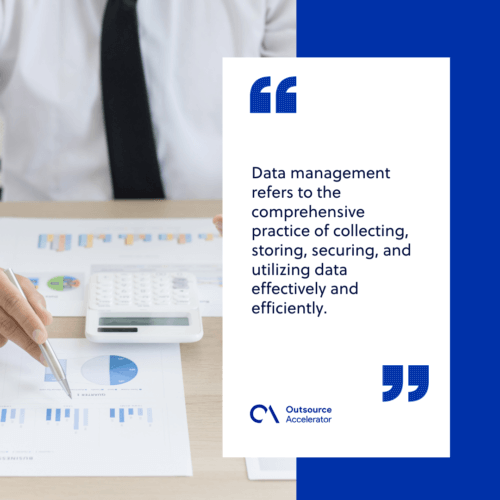Data management best practices: Transforming data into powerful insights

This article is a submission by SuccessLink Outsourcing. SuccessLink Outsourcing is a leading provider of customized outsourcing solutions, dedicated to refining business operations across diverse industries.
In today’s data-driven world, businesses generate and collect an overwhelming amount of information every day. Yet, the real value lies not in the volume of data but in how effectively it is managed, analyzed, and turned into actionable insights.
Proper data management isn’t just a technical necessity; it’s a strategic advantage that can help organizations innovate, improve efficiency, and outpace the competition.
Whether you’re a small startup or an established enterprise, adopting robust data management practices is crucial.
In this blog, we’ll explore essential best practices for managing data, ensuring it’s both a reliable resource and a competitive asset.
Understanding the importance of data management
Data management refers to the comprehensive practice of collecting, storing, securing, and utilizing data effectively and efficiently.
Good data management ensures that information is accurate, accessible, and usable when needed. But why is this so critical?
- Enhanced decision-making: Reliable data allows organizations to make informed and confident decisions.
- Regulatory compliance: With regulations like GDPR and CCPA, proper data handling is not optional but mandatory to avoid hefty penalties.
- Cost efficiency: Managing data effectively reduces redundancies, streamlines operations, and minimizes storage costs.
- Improved customer experience: Insights from data can personalize interactions and improve customer satisfaction.

Key best practices for data management
1. Establish a data governance framework
Data governance defines the rules, processes, and responsibilities for managing data assets within an organization. Without clear governance, data management efforts can become fragmented, leading to inconsistencies and errors.
- Create a data governance team: Assign stakeholders across departments to oversee data quality and compliance.
- Define policies: Establish clear policies regarding data usage, access, and storage.
- Monitor compliance: Regular audits ensure adherence to established rules.
2. Prioritize data quality
Low-quality data results in faulty analyses and poor choices. To ensure high data quality:
- Clean your data regularly: Identify and remove inaccuracies, duplicates, and outdated information.
- Standardize data entry: Use consistent formats and rules for data collection to minimize errors.
- Implement validation tools: Automated tools can help catch errors during the data entry process.
3. Use a centralized data repository
Storing data in silos can lead to inefficiencies and missed opportunities. A centralized data repository ensures all teams have access to the same accurate and up-to-date information.
- Adopt cloud-based solutions: Cloud platforms provide scalability, security, and easy access for remote teams.
- Leverage data warehousing: Invest in a robust data warehouse for structured storage and quick retrieval.
4. Ensure data security
Protecting sensitive data is a must given the increase in cyberthreats.
Data breaches not only harm reputations but also result in legal repercussions and financial losses.
- Encrypt data: Protect sensitive information both in transit and at rest with encryption.
- Limit access: Implement role-based access control (RBAC) to restrict data access to authorized personnel.
- Regularly update security protocols: Stay ahead of emerging threats by keeping your systems and practices up to date.
5. Invest in data integration
Most businesses use multiple platforms and tools, which can lead to fragmented data. Data integration connects these systems, creating a unified view of information.
- Use integration tools: Platforms like ETL (Extract, Transform, Load) can automate and simplify data integration.
- Establish API connections: Application Programming Interfaces (APIs) ensure seamless communication between systems.
6. Focus on data analytics and visualization
The value of raw data depends on the insights it yields. Analytics and visualization tools transform numbers into understandable and actionable insights.
- Adopt modern tools: Use platforms like Tableau, Power BI, or Google Data Studio for dynamic data visualization.
- Encourage collaboration: Empower teams to interact with data dashboards and derive insights collaboratively.
7. Regularly backup data
Human error, cyberattacks, or hardware malfunctions can all cause data loss. Regular backups ensure business continuity and mitigate risks.
- Automate backups: Set up automated schedules to ensure regular and consistent backups.
- Store backups offsite: Use cloud storage or external locations to safeguard against physical damage.
8. Train your team
Even the best tools and policies are ineffective if your team lacks the knowledge to use them. Regular training ensures everyone understands the importance of data management and their role in maintaining it.
- Host workshops: Provide training sessions for employees at all levels.
- Create documentation: Maintain user guides and protocols for reference.
- Promote a data-driven culture: Encourage employees to use data in their daily decision-making processes.
9. Leverage automation and AI
Automation and artificial intelligence (AI) tools can simplify repetitive tasks, improve accuracy, and uncover hidden patterns in data.
- Automate data cleaning: Use AI tools to identify and resolve inconsistencies.
- Implement predictive analytics: AI can help forecast trends and prepare for future scenarios.
- Streamline reporting: Automated reporting tools save time and ensure accuracy.
10. Continuously review and improve
Data management is not a “set-it-and-forget-it” process. Regularly reviewing your strategies and tools ensures they evolve alongside your business needs.
- Monitor key metrics: Track metrics like data accuracy, accessibility, and processing time.
- Seek feedback: Encourage input from your team to identify bottlenecks or areas for improvement.
- Stay updated: Stay abreast of new developments in technology and the industry.

The benefits of effective data management
Organizations that prioritize data management reap numerous rewards:
- Operational efficiency: Streamlined processes save time and resources.
- Better risk management: Proper data security and compliance reduce vulnerabilities.
- Increased revenue: Data insights enable targeted marketing and product development.
- Enhanced agility: Quick access to accurate data helps businesses respond rapidly to market changes.
Common pitfalls to avoid
Even with the best intentions, some common mistakes can derail your data management efforts:
- Neglecting scalability: Ensure your systems can handle growing data volumes as your business expands.
- Overlooking data privacy: Ignoring compliance regulations can lead to legal troubles.
- Ignoring unstructured data: Valuable insights often lie in unstructured data like emails or social media posts.
Ready to transform your data strategy?
Data management forms the foundation to modern business success. By following these best practices, organizations can unlock the full potential of their data, turning raw information into actionable insights that drive growth and innovation.
It’s clear that effective data management is essential for organizations to optimize decision-making, improve operational efficiency, and ensure data security and compliance.
By implementing best practices such as data governance, quality assurance, and data lifecycle management, businesses can harness the full potential of their data assets and drive sustainable growth and innovation.







 Independent
Independent




